For guitarists of all levels, the quest for better tone and technique is ongoing. While gear and practice routines are often the focus, sometimes the smallest adjustments can yield the biggest improvements. One such often-overlooked fundamental is How To Hold A Guitar Pick. It might seem trivial, but your pick grip significantly impacts your control, tone, and playing style. Whether you’re a beginner just starting out or a seasoned player looking to refine your technique, understanding the nuances of holding a pick is crucial.
Many players, even those with years of experience, find that revisiting their pick grip can unlock new levels of playing. You might have seen online discussions or heard from fellow musicians about how a simple change in pick grip revolutionized their sound and control. This article explores the essential techniques for how to hold a guitar pick, diving into different methods, their pros and cons, and how to find the grip that best suits your musical style.
There isn’t one “right” way to hold a guitar pick, but understanding the common techniques and experimenting with them is key to developing your personal optimal grip. Let’s break down three primary methods, often referred to as the “O grip,” “pinch grip,” and “fist grip,” to help you navigate this fundamental aspect of guitar playing.
Exploring the “O Grip”: A Balanced Approach
The “O grip” is arguably the most commonly taught and widely used method for how to hold a guitar pick. It’s often favored for its balance of control and tonal versatility, making it suitable for a wide range of musical genres and playing styles.
To execute the “O grip,” imagine making an elongated “O” shape with your thumb and index finger. The pick is held between the side of your thumb and the side of your index finger’s first knuckle. The tip of your thumb and the side of your index finger should meet gently, applying enough pressure to secure the pick without excessive tightness. The remaining fingers typically curl naturally into the palm, though some players prefer to keep them slightly extended.
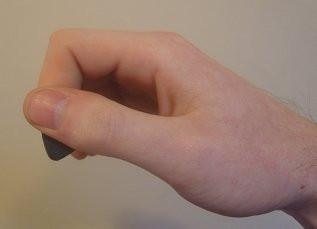 O Grip Guitar Pick Method – Side View
O Grip Guitar Pick Method – Side View
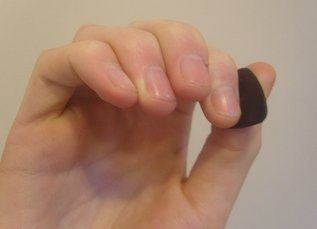 O Grip Guitar Pick Method – Top View
O Grip Guitar Pick Method – Top View
Pros of the “O Grip”:
- Versatility: Well-suited for both rhythm and lead playing, strumming and single-note picking.
- Control: Offers a good balance of control over pick depth and angle, allowing for nuanced dynamics.
- Tone: Produces a balanced tone, not too bright or too muffled, adaptable to various musical styles.
Cons of the “O Grip”:
- Can feel less secure for heavy strumming: Might require a slightly tighter grip for aggressive strumming, potentially leading to tension.
- Less flexibility for subtle dynamic changes: Compared to the pinch grip, it offers slightly less flexibility for very subtle dynamic variations in strumming.
The “O grip” is a solid foundation and an excellent starting point for most guitarists learning how to hold a guitar pick. Its versatility makes it a reliable choice for players who navigate different styles and techniques.
The “Pinch Grip”: Emphasizing Flexibility
The “pinch grip” offers a different approach, prioritizing flexibility and a lighter touch. This method of how to hold a guitar pick is often favored by players who frequently employ strumming techniques, particularly in styles like folk, pop, or reggae, where a softer, more rhythmic approach is desired.
In the “pinch grip,” the pick is held primarily between the thumb and the flat of the index finger. Instead of using the side of the index finger as in the “O grip,” the pick rests against the underside of the index finger, closer to the fingertip. This grip allows for greater flexibility in the pick itself and in the movement of the wrist and fingers.
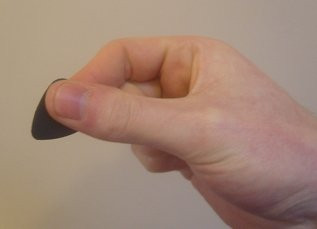 Pinch Grip Guitar Pick Method – Side View
Pinch Grip Guitar Pick Method – Side View
 Pinch Grip Guitar Pick Method – Top View
Pinch Grip Guitar Pick Method – Top View
Pros of the “Pinch Grip”:
- High Flexibility: Ideal for strumming and creating a lighter, more airy tone.
- Dynamic Control: Allows for subtle dynamic changes in strumming patterns due to increased pick flexibility.
- Suited for light gauge picks: Works particularly well with thinner, more flexible guitar picks.
Cons of the “Pinch Grip”:
- Less Control for Fast Picking: Can be less precise for fast, articulate single-note lines or aggressive lead playing.
- Tone can be thinner: May produce a thinner or less powerful tone compared to other grips, especially with heavier gauge strings.
- Pick slippage: Requires a very light touch to maintain flexibility, which can sometimes lead to the pick slipping if not held carefully.
If your playing style leans heavily towards strumming and you prefer a softer, more nuanced dynamic, the “pinch grip” might be the perfect technique for how to hold a guitar pick for you.
The “Fist Grip”: Power and Attack
The “fist grip,” sometimes referred to as the “flatpick grip,” is characterized by a more closed hand position and a firmer hold on the pick. This method of how to hold a guitar pick is often favored by players in genres like bluegrass, country, and heavier rock styles where a strong, assertive tone and powerful attack are desired.
In the “fist grip,” the index finger is curled more significantly, often parallel to the thumb, creating a more closed fist-like shape around the pick. The pick is held firmly between the thumb and the side of the index finger, often deeper into the hand than the “O grip.” This grip emphasizes power and control over the pick’s angle and depth.
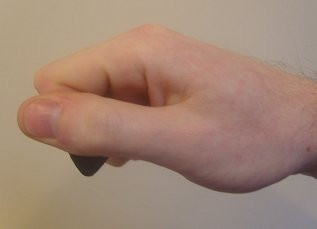 Fist Grip Guitar Pick Method – Side View
Fist Grip Guitar Pick Method – Side View
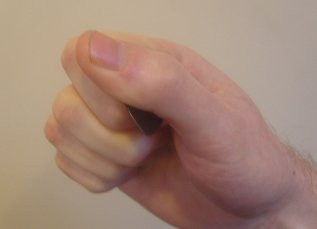 Fist Grip Guitar Pick Method – Top View
Fist Grip Guitar Pick Method – Top View
Pros of the “Fist Grip”:
- Powerful Tone: Produces a strong, full tone with a powerful attack, ideal for genres requiring aggressive picking.
- Control for Heavy Gauge Picks: Works well with thicker, heavier gauge picks favored in bluegrass and heavier styles.
- Precise Downstrokes: Offers excellent control for strong and articulate downstrokes.
Cons of the “Fist Grip”:
- Less Flexibility: Can feel less flexible for strumming and subtle dynamic changes.
- Can be Tense: The firmer grip can lead to tension in the hand and wrist if not executed with relaxation.
- Might be less versatile: May be less adaptable to a wide range of musical styles compared to the “O grip.”
For players seeking maximum power and control, particularly in genres that demand a strong attack and assertive tone, the “fist grip” is a valuable technique to explore when learning how to hold a guitar pick.
Finding Your Ideal Grip: Experimentation is Key
Ultimately, the “best” way to hold a guitar pick is subjective and depends on your individual playing style, musical preferences, and hand anatomy. The techniques described above are starting points, and many players develop variations and hybrid grips over time.
Here’s a practical approach to finding your optimal pick grip:
- Experiment with each of the three methods: Spend dedicated practice time trying each grip – “O grip,” “pinch grip,” and “fist grip.” Focus on playing scales, chords, and simple songs you already know with each grip.
- Vary pick gauges: Try different pick thicknesses (gauges) with each grip. Lighter picks might feel better with the “pinch grip,” while heavier picks might suit the “fist grip.” Explore a range from thin (.38mm) to heavy (1mm+) to see how they interact with each grip.
- Listen to your tone: Pay close attention to the tone produced by each grip and pick combination. Does it sound how you want? Is it suitable for the music you play?
- Assess comfort and control: Which grip feels most comfortable and natural in your hand? Which grip gives you the most control over your picking and strumming?
- Don’t be afraid to adapt: You might find that a combination of techniques or a slight modification of one of these grips works best for you. Many players subtly adjust their grip over time as their technique evolves.
Consistency is crucial. Once you’ve identified a grip (or a few grips for different styles) that feels promising, stick with it for a while. Muscle memory takes time to develop, and constantly switching grips can hinder your progress.
Consider your musical goals. If you primarily play acoustic folk music, the “pinch grip” might naturally feel more comfortable. If you’re into heavy metal, the “fist grip” might provide the power you need. Let your musical style guide your experimentation.
The Journey of Refinement
Learning how to hold a guitar pick effectively is an ongoing process. Even experienced players periodically revisit their technique to refine their tone and control. Don’t get discouraged if it feels awkward at first; with consistent practice and experimentation, you’ll find the grip that unlocks your best playing. Remember, the goal is to find a grip that feels natural, comfortable, and allows you to express yourself musically. So, pick up your guitar, experiment with these techniques, and embark on the journey to mastering your pick grip and elevating your guitar playing.
